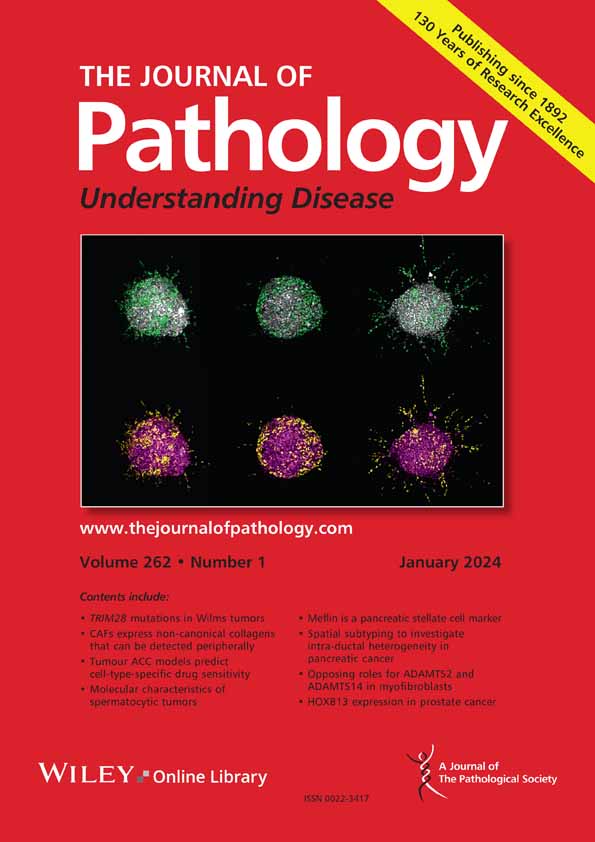Zhen Wang, Jin Yuan, Xuemei Qin, Hongzhen Yin, Changshun Zhong, Rui Qu, Guannan Wang
求助PDF
{"title":"LncRNA GAS5 ameliorates intestinal barrier injury by targeting the miR-223-3p/FBXW7 axis and inactivating NF-κB signaling in vitro and in vivo","authors":"Zhen Wang, Jin Yuan, Xuemei Qin, Hongzhen Yin, Changshun Zhong, Rui Qu, Guannan Wang","doi":"10.1002/path.6440","DOIUrl":null,"url":null,"abstract":"<p>Sepsis is a potentially lethal syndrome that leads to multiple organ dysfunction. LncRNA <i>GAS5</i> is closely related to sepsis; however, its detailed functions and mechanism in sepsis-triggered intestinal barrier dysfunction are unclear. In this study, NCM460 cells were stimulated with lipopolysaccharide (LPS) to mimic septic intestinal injury <i>in vitro</i>, and a sepsis mouse model was established via the cecum ligation and perforation method. Terminal deoxynucleotidyl transferase dUTP nick end labeling staining was performed for cell apoptosis evaluation. RNA and protein levels were examined by RT-qPCR and western blotting, respectively. Additionally, cell permeability and intestinal mucosa permeability were measured. ELISA was utilized to detect inflammatory cytokine production. H&E staining was conducted for histologic examination of the intestine. Luciferase reporter and RNA pull-down assays were employed to verify the interaction between <i>GAS5</i>, <i>miR-223-3p</i>, and <i>FBXW7</i>. The results showed that <i>GAS5</i> was downregulated in LPS-exposed NCM460 cells as well as the intestine of septic mice. <i>GAS5</i> overexpression mitigated LPS-triggered intestinal epithelial cell damage and apoptosis <i>in vitro</i> and reduced pathological damage, inflammation, and intestinal hyperpermeability in septic mice. <i>GAS5</i> upregulated <i>FBXW7</i> by interacting with <i>miR-223-3p</i>. Depletion of <i>FBXW7</i> reversed the protective effects of <i>GAS5</i> overexpression <i>in vitro</i>. Additionally, <i>GAS5</i> overexpression inactivated NF-κB signaling in LPS-stimulated NCM460 cells. NF-κB inactivation exerted effects in septic mice similar to those observed with <i>GAS5</i> overexpression. In conclusion, <i>GAS5</i> ameliorates sepsis-triggered intestinal barrier disruption by mediating the <i>miR-223-3p</i>/<i>FBXW7</i> axis and inactivating NF-κB signaling. © 2025 The Pathological Society of Great Britain and Ireland. Published by John Wiley & Sons, Ltd.</p>","PeriodicalId":232,"journal":{"name":"The Journal of Pathology","volume":"267 1","pages":"25-39"},"PeriodicalIF":5.2000,"publicationDate":"2025-07-28","publicationTypes":"Journal Article","fieldsOfStudy":null,"isOpenAccess":false,"openAccessPdf":"","citationCount":"0","resultStr":null,"platform":"Semanticscholar","paperid":null,"PeriodicalName":"The Journal of Pathology","FirstCategoryId":"3","ListUrlMain":"https://pathsocjournals.onlinelibrary.wiley.com/doi/10.1002/path.6440","RegionNum":2,"RegionCategory":"医学","ArticlePicture":[],"TitleCN":null,"AbstractTextCN":null,"PMCID":null,"EPubDate":"","PubModel":"","JCR":"Q1","JCRName":"ONCOLOGY","Score":null,"Total":0}
引用次数: 0
引用
批量引用
Abstract
Sepsis is a potentially lethal syndrome that leads to multiple organ dysfunction. LncRNA GAS5 is closely related to sepsis; however, its detailed functions and mechanism in sepsis-triggered intestinal barrier dysfunction are unclear. In this study, NCM460 cells were stimulated with lipopolysaccharide (LPS) to mimic septic intestinal injury in vitro , and a sepsis mouse model was established via the cecum ligation and perforation method. Terminal deoxynucleotidyl transferase dUTP nick end labeling staining was performed for cell apoptosis evaluation. RNA and protein levels were examined by RT-qPCR and western blotting, respectively. Additionally, cell permeability and intestinal mucosa permeability were measured. ELISA was utilized to detect inflammatory cytokine production. H&E staining was conducted for histologic examination of the intestine. Luciferase reporter and RNA pull-down assays were employed to verify the interaction between GAS5 , miR-223-3p , and FBXW7 . The results showed that GAS5 was downregulated in LPS-exposed NCM460 cells as well as the intestine of septic mice. GAS5 overexpression mitigated LPS-triggered intestinal epithelial cell damage and apoptosis in vitro and reduced pathological damage, inflammation, and intestinal hyperpermeability in septic mice. GAS5 upregulated FBXW7 by interacting with miR-223-3p . Depletion of FBXW7 reversed the protective effects of GAS5 overexpression in vitro . Additionally, GAS5 overexpression inactivated NF-κB signaling in LPS-stimulated NCM460 cells. NF-κB inactivation exerted effects in septic mice similar to those observed with GAS5 overexpression. In conclusion, GAS5 ameliorates sepsis-triggered intestinal barrier disruption by mediating the miR-223-3p /FBXW7 axis and inactivating NF-κB signaling. © 2025 The Pathological Society of Great Britain and Ireland. Published by John Wiley & Sons, Ltd.
在体外和体内研究中,LncRNA GAS5通过靶向miR-223-3p/FBXW7轴和灭活NF-κB信号通路来改善肠屏障损伤。
败血症是一种潜在的致命综合征,可导致多器官功能障碍。LncRNA GAS5与脓毒症密切相关;然而,其在脓毒症引发的肠屏障功能障碍中的具体功能和机制尚不清楚。本研究采用脂多糖(LPS)刺激NCM460细胞体外模拟脓毒症肠道损伤,并采用盲肠结扎穿孔法建立脓毒症小鼠模型。采用末端脱氧核苷酸转移酶dUTP缺口末端标记法评价细胞凋亡。RT-qPCR和western blotting分别检测RNA和蛋白水平。测定细胞通透性和肠黏膜通透性。ELISA法检测炎症细胞因子的产生。采用H&E染色对小肠进行组织学检查。采用荧光素酶报告基因和RNA下拉实验验证GAS5、miR-223-3p和FBXW7之间的相互作用。结果显示,在lps暴露的NCM460细胞和脓毒症小鼠的肠道中,GAS5表达下调。GAS5过表达减轻了lps引发的肠上皮细胞损伤和凋亡,减轻了脓毒症小鼠的病理损伤、炎症和肠道高通透性。GAS5通过与miR-223-3p相互作用上调FBXW7。在体外,FBXW7的缺失逆转了GAS5过表达的保护作用。此外,在lps刺激的NCM460细胞中,GAS5过表达使NF-κB信号失活。NF-κB失活对脓毒症小鼠的影响与GAS5过表达小鼠相似。综上所述,GAS5通过介导miR-223-3p/FBXW7轴和灭活NF-κB信号通路,改善脓毒症引发的肠屏障破坏。©2025英国和爱尔兰病理学会。约翰·威利父子有限公司出版。
本文章由计算机程序翻译,如有差异,请以英文原文为准。





 求助内容:
求助内容: 应助结果提醒方式:
应助结果提醒方式:


